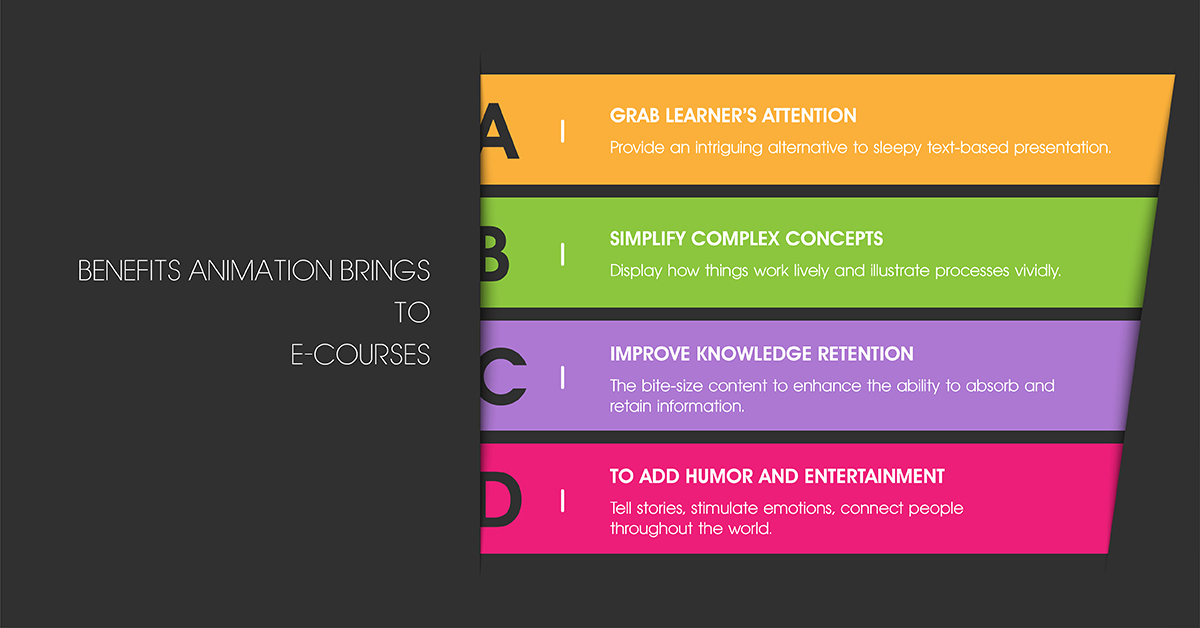Benefits Animation Brings to E-courses (With Examples)
In today’s busy world, people often have to respond to the challenge of juggling multiple responsibilities. Boosting productivity in work and study, therefore, has become more urgent than ever. That’s where digital training comes in. It helps these busy bees broaden their knowledge and upskill on the move. However, as they slave at multitasking and have a short attention span, they can get distracted easily in the hustle and bustle of everyday life.
Engaging learners, hence, can be a very challenging task in eLearning. How can course creators keep learners focused and maintain their motivation during an e-course? Fortunately, animation in eLearning can help resolve this issue. In this article, let’s delve into the benefits animation brings to e-courses.

This article covers:
- History of Animation
- Overview of Animation in eLearning
- Benefits Animation Brings to E-courses with Examples
To begin with, why not grab the fascinating history of animation and its short overview in eLearning to have a comprehensive look at this subject?
History of Animation
3,000 B.C.
Speaking of animation, some of us may think that it is a modern medium. However, its history dates back to prehistoric times. Archeological artifacts prove that humans have probably attempted to depict things in motion since they could draw. It is believed that Grecian pottery was an early form of animation. The pottery was decorated with figures in successive stages of action. Through the figures, ancient Greeks wanted to capture moments of their everyday life, beliefs, myths, or deities. Spinning the pottery, you could feel a sense of motion:

Pixabay
Animation Before Film
Much later, people invented various pre-film animation devices that put drawings together to produce the illusion of motion. The notable ones include The Magic Lantern, Thaumatrope, Phenakistoscope, Zoetrope, Flipbook, Movieola, etc. For example, the Phenakistoscope featured rotating discs reflected in mirrors. The discs contain figures evenly spaced around and small rectangular apertures at the rim. This animation device can help viewers feel the illusion of motion through the slits of the rotating discs in front of mirrors. It then became a favorite plaything across Europe:

Phenakistoscopes from The Public Domain Review
The Golden Age of Animation
Went through different stages of development, animation has existed in many shapes and forms before evolving into the golden age. The rise of Walt Disney, MGM, Warner Brothers, and Max Fleischer has brought viewers the best animated movies ever. It will be a shortcoming without mentioning the most favorite cartoons such as:
- Steamboat Willie
- Silly Symphonies
- Tom and Jerry
- Betty Boop
- Popeye
- Merrie Melodies
- Snow White and the Seven Dwarfs
- Beauty and the Beast
- …
Most recently, with the development of CGI (computer generated imagery), drawing is replaced by 3D technology. Thanks to that, many computer-animated cartoons are produced like The Simpsons, Frozen, Toy Story, Big Hero…

The Simpsons Family from Wikipedia
Overview of Animation in eLearning
All of the listed historical facts above lead up to the animation we know today. It appears in all aspects of life. No matter what people exactly do to create animation, it is a powerful creative tool for humans to convey information throughout history. Why do people love this tool so much? That’s because of its ability to:
- Grab and refocus attention.
- Convey basic or complex concepts in a unique and easy-to-perceive way that both children and adults can understand.
- Improve knowledge retention.
- Tell stories, stimulate emotions, connect people throughout the world no matter their languages, beliefs, biases, or interests.
The benefits animation brings can apply to all aspects, including eLearning. Let’s dig into each of its impacts in eLearning in turn.
Benefits Animation Brings to E-courses with Examples
Below are four main benefits animation brings to e-courses:
Benefits Animation Brings to E-courses #1: To Grab Learner’s Attention
Ease of access is one of the online training advantages. This method allows learners to study anytime and anywhere. However, this benefit also comes with a disadvantage. That is, it is easy to become distracted during an online learning session. When learners study on a commute or employees work from home, many factors can disturb them. For example, app notifications, messages, the noise around, or simply the walls of text bored them.
So, what has gone wrong with this online training method? There is nothing wrong with the lesson content itself. The issue arises from the way course creators convey knowledge. As you already know from the previous article, static slides are not preferred. No one wants to read the walls of text. Interactive learning is now a favorite trend. Human beings, in general, and learners, in particular, respond best to visual stimuli. Course developers can create this factor to take advantages of benefits animation brings to e-courses.
Example 1: Animated Charts (A sample of Saola Animate 3.0)
Click on the Prev or Next button to move backward or forward.
Animation can support educators in showing information in motion. It provides an intriguing alternative to sleepy text-based presentation. The Animated Chart project above is a great example. Animated objects, including colored shapes, images, and text, were used to show statistics. Besides, after appearing on the screen with eye-catching animations, the slides take time for viewers to read all the information at their own pace. Then, they can interact with the course by clicking a button to move backward or forward. Between an e-course with lengthy text and another containing motion graphics, which one can capture the learner’s attention better?
Benefits Animation Brings to E-courses #2: To Simplify Complex Concepts
Simplifying complex concepts is another benefits animation brings to e-courses. Many complex concepts cannot be described by words or live-action videos/ films. Also, many phenomena or scenarios cannot be seen or imagined. For example, the inner workings of the human body, complex economic models, crime-solving or large-scale geographical processes, the evolution of human beings, etc.
Example 2: Human Evolution (A sample of Saola Animate 3.0)
Click on the Next Stage button to see the appearance change.
In these cases, if course developers use text to describe the information, learners may find it difficult to understand or imagine. It makes the course content indigestible. Learners become bored and tired quickly. And you know, boredom is the biggest enemy of studying. Meanwhile, live-action videos or films will not be a good option too. It is not safe for the main characters to shoot the scenes in some types of video or movie.
That is where the animation comes in to overcome the problem. It is an engaging tool to display how things work lively and illustrate processes vividly. As you can see, the project Human Evolution above helps to exhibit the evolution of human appearance with historical milestones and background music. Thanks to that, historical knowledge is digestible and does not make learners drowsy.
Benefits Animation Brings to E-courses #3: To Improve Knowledge Retention
A picture is worth a thousand words. You may have heard this concept before. According to MIT neuroscientists, the human brain can process a dozen images that the eye sees for as little as 13 milliseconds. That’s maybe the reason many learners prefer visual aids like images, videos, infographics to text. And, did you know that animation even helps improve knowledge retention better than images? In other words, we can say it is worth a thousand pictures. Let’s take a look at the below example:
Example 3: The ASEAN Infographic (A sample of Saola Animate 3.0)
Click anywhere in the infographic to pause or continue the presentation.
This infographic shows historical events, demographic and economic statistics by using different visual styles. The way information is presented in motion helps attract learners’ attention. The entrance and exit effects of icons, images, text, and the brevity of words and numbers help viewers easily memorize them. Learners can quickly remember four main sections of the course content.
Besides, the content is broken down into bite-size chunks. To review one of these sections, click a button corresponding to that session. For example, the presentation is displaying economic statistics. However, it is still possible for viewers to click on the History button to read this section again if they want. Besides, they can also pause or continue the presentation by clicking anywhere in the infographic. Applying microlearning avoids overwhelming learners with too much information while not all are necessary. This method increases the ability to absorb and retain information.
Benefits Animation Brings to E-courses #4: To Add Humor and Entertainment
In the History of Animation section, you already see the benefits animation brings to human entertainment. To be more convinced, let’s think about the famous cartoon Tom and Jerry. Despite being created in 1940, the cartoon is still on the list of the most favorite comic strips of many children and adults. Almost everyone who watched the movie burst out laughing at the scenes where Tom chased Jerry. This animated movie is a clear demonstration of how animations can help stimulate emotions.
Animation, without doubt, has the ability to tell a story, inspire people, and convey important messages. In eLearning, it helps replace dull and dry information, abstract and theory-based knowledge. The combination of visual and auditory elements in an e-course can not only excite learners but also relax them.
Example 4: Way Back Home (A sample of ActivePresenter 8)
Click the Play button to try this quiz.
Therefore, course creators can design small games or quizzes to create a fun atmosphere for the online learning environment. It is a helpful way to summarize knowledge and assess students’ learning online.
Final Words
Not all animation needs to be as complicated as Disney or Pixar’s cartoons. In contrast, animations in eLearning should be simple not to divert learners from the main topic. Some applications can support educators to take advantage of the benefits animation brings to e-courses such as ActivePresenter and Saola Animate.
ActivePresenter is a powerful tool for creating engaging eLearning games or quizzes with simple animations. Meanwhile, Saola Animate can help design complex HTML5 animations not only for online courses but also interactive web content. You can download ActivePresenter and Saola Animate for free trial.
